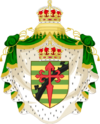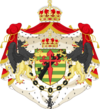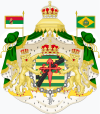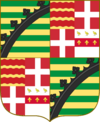Coat of arms of Ebenthal
| Coat of arms of Ebenthal | |
|---|---|
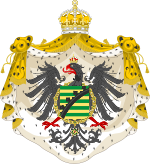 | |
| Versions | |
 Lesser arms | |
 Royal arms | |
| Details | |
| Armiger | Arthur II, King of Ebenthal |
| Adopted | 1 January 2024 |
| Crest | The royal crown. |
| Escutcheon | Barry of ten Vert and Or, a crancelin Sable sinister. |
| Supporters | Prussian eagle. |
| Orders | Order of Prince Ludwig Gaston of Saxe-Coburg and Braganza. |
| Other elements | The whole within a jaguar-themed mantle Or doubled Ermine surmounted by the royal crown proper. |
The Coat of arms of Ebenthal (Portuguese: Brasão de armas de Ebenthal) is an English-type shield composed by ten stripes, five green (Vert) and five yellow (Or), crossed from top right to bottom left by a black (Sable) crancelin. In its current grand version, the lesser arms are presented encircled by the collar of the Order of Prince Ludwig Gaston of Saxe-Coburg and Braganza, Ebenthal's highest honour, within a jaguar-themed golden (Or) topped by the royal diamond crown. Additionally, since the promulgation of the Ebenthaler Constitution of 2024, the coat of arms of the House of Bruyn, the Royal Family of Ebenthal, in which two of its quadrants feature the lesser arms, is equally considered as a coat of arms of the kingdom, commonly designated as "royal arms", and used interchangeably with the lesser arms.
The coat of arms design was created by King Arthur II, inspired by a first project gifted to him by the Emperor Oscar I of Karnia-Ruthenia. The initial project was adopted following approval by Ebenthal's former parliament in 3 May 2020. Ever since, it underwent modifications such as the escutcheon shape. The foremost modification however was the drop of the Cross of Saint James, formerly the country's ultimate ensign.
Symbolism
The coat of arms colors and style were heavily inspired by and it is a reference to the House of Saxe-Coburg and Gotha, former owner to the Castle of Ebenthal, in Austria, after which the country was named. The escutcheon, or shield, mimics the one of the aforementioned royal house, changing the place of colors (the original black and yellow stripes became green and a different ton of yellow, whereas the green crancelin was inverted and colored black).
The yellow and green from the stripes, together with the black from the crancelin, the primary colors of the House of Saxe-Coburg and Gotha are meant to represent Ebenthal's inspirational background and thus its history. The Cross of Saint James, present in every Ebenthalian national symbol prior to the current arms, was meant to represent the continuity of the Ebenthalian historyand the people's mostly Portuguese background, as a reference to the Order of Saint James of the Sword; however in late 2023 the religious symbol was removed from the arms following the approval of a law against the mixing of religious and political aspects.
The golden mantle actually mimics the skin of a jaguar, Ebenthal's national animal, and thus it represents the country's nature and location, as jaguars are endemic to Latin America. Finally, the mantle is surmounted by the heraldic crown of Ebenthal was inspired by the crowns of the Brazilian and the Indian empires.
Historical coat of arms
From its establishment, Ebenthal has had various official coats of arms. In 2020, the current escutcheon, or small arms, was introduced, which has been in force on Ebenthal's official arms since then. However, approved on 17 December 2023, from 1 January 2024, for the first time since the kingdom's independence, its coat of arms will no longer have the Cross of Saint James.
Grand arms
| Extended content | ||||||||||||||||||||||||||||||||||||
|---|---|---|---|---|---|---|---|---|---|---|---|---|---|---|---|---|---|---|---|---|---|---|---|---|---|---|---|---|---|---|---|---|---|---|---|---|
|

